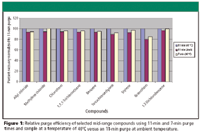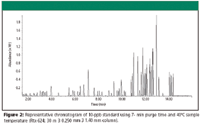Techniques for Reducing Purge-and-Trap Cycle Times in VOC Analysis
The Application Notebook
The purge-and-trap (P&T) technique for analysis of volatile organic compounds (VOCs) was pioneered in the 1970s at the United States Environmental Protection Agency (USEPA) research laboratory in Cincinnati. Many of the operational parameters developed during this time period are still included in USEPA methods. While these parameters still produce good analytical results, they do not take advantage of advances in instrumentation that enable analysis of emerging contaminants such as fuel oxygenates, and increased sample throughput.
The purge-and-trap (P&T) technique for analysis of volatile organic compounds (VOCs) was pioneered in the 1970s at the United States Environmental Protection Agency (USEPA) research laboratory in Cincinnati. Many of the operational parameters developed during this time period are still included in USEPA methods. While these parameters still produce good analytical results, they do not take advantage of advances in instrumentation that enable analysis of emerging contaminants such as fuel oxygenates, and increased sample throughput.
The USEPA recently reported on its efforts to update Method 524.2 for the Determination of Volatile Organic Compounds in Drinking Water (1,2). Stated goals of this work include developing criteria to permit laboratories flexibility to modify prescriptive parameters in the method while maintaining data quality and improving throughput.

Figure 1
Experimental Conditions
Instrumentation used for this study included an OI Analytical Eclipse 4660 Purge-and-Trap Sample Concentrator equipped with a Infra-Sparge™ sample heater, a 4551A Vial autosampler, and an Agilent 6890/5975 GC–MS.
Four 5-mL aliquots of a 25-ppb standard containing 86 compounds from the USEPA Method 524.2 list were analyzed using variable purge times from 1 to 11 min, while maintaining sample temperature at either 40°C or at ambient laboratory temperature.

Figure 2
Results
Data collected in this study demonstrate that maintaining sample temperatures at 40°C during the purge step allows a reduction in purge time from 11 to 7 min without compromising analytical performance (3). This finding is consistent with results reported by the USEPA indicating a 7-min purge time is sufficient for VOC methods (2).
Conclusions
This study confirms that the purge time in a VOC analysis can be reduced from 11 to 7 min when the sample temperature is maintained at 40°C. Keeping the sample temperature at 40°C during purge also improves purge efficiency, increases compound recovery, and enhances overall instrument performance. Reducing P&T cycle time by 4-min per sample significantly improves sample throughput and provides a means to increase laboratory productivity and profitability.
References
(1) Revision of EPA Method 524.2 for the Determination of Volatile Organic Compounds in Drinking Water, B. Prakash, B.V. Pepich, A. Zaffiro, and D.J. Munch, Proceedings of Water Quality Technology Conference, November 5–9, 2006, Denver, Colorado.
(2) Improvements to USEPA Method 524.2 for the Determination of Volatile Organics, B. Prakash, Proceedings of National Environmental Monitoring Conference, August 19–25, 2007, Cambridge, Massachusetts.
(3) OI Analytical Application Note 3012, "Reduction of Purge-and-Trap (P&T) Cycle Times in Volatile Organic Compounds (VOCs) Analysis," 2007.

OI Analytical
P.O. Box 9010
College Station, TX 77842-9010
Tel: (979) 690-1711; Fax: (979) 690-0440
Email: oimail@oico.com

Separation of Ultra-Short and Long Chain PFAS Compounds Using a Positive Charge Surface Column
December 11th 2024A separation of ultra-short and long chain PFAS (C1-C18) is performed on a HALO®PCS Phenyl-Hexyl column along with a HALO®PFAS Delay column which demonstrates excellent retention for both hydrophilic and hydrophobic analytes.














